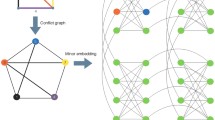Abstract
This paper explores the use of the meta-heuristic search algorithm Simulated Annealing for solving a minimum cost network synthesis problem. This problem is a common one in the design of telecommunication networks. The formulation we use models a number of practical problems with hop-limit, degree and capacity constraints. Emphasis is placed on a new approach that uses a knapsack polytope to select amongst a number of pre-computed traffic routes in order to synthesise the network. The advantage of this approach is that a subset of the best routes can be used instead of the whole set, thereby making the process of designing large networks practicable. Using simulated annealing, we solve moderately large networks (up to 30 nodes) efficiently.
Similar content being viewed by others

References
D. Abramson and M. Randall, “A simulated annealing code for general integer linear programs,” Annals of Operations Research, vol. 86, pp. 3–21,1999.
A. Balakrishnan, T. Magnanti, A. Shulman, and R. Wong, “Models for planning capacity expansion in local access telecommunication networks,”Annals of Operations Research, vol. 33, pp.239–284,1991.
L. Berry, B. Murtagh, S. Sugden, and G. McMahon, “Application of a genetic-based algorithm for optimal design of tree-structured communications networks,” in Proceedings of the Regional Teletraffic Engineering Conference of the International Teletraffic Congress, South Africa, 1995, pp. 361–370.
L. Berry, B. Murtagh, S. Sugden, and G. McMahon, “An integrated GA-LP approach to communication network design,” in Proceedings of the 2nd IFIP Workshop on Traffic Management and Synthesis of ATM Networks, Canada, 1997.
N. Collins, R. Eglese, and B. Golden, “Simulated annealing: An annotated bibliography,” American Journal of Mathematical and Management Sciences, vol. 8, pp. 209–307, 1988.
D. Connolly, “An improved annealing for the QAP,” European Journal of Operational Research, vol. 46, pp. 93–100, 1990.
R. Eglese, “Simulated annealing: A tool for operational research,” European Journal of Operational Research,vol. 46, pp. 271–281,1990.
B. Gavish, “Augmented Lagrangian based algorithms for centralised network design,” IEEE Transactions on Communications, vol. 33, pp.1247–1257,1985.
D. Goldberg, Genetic Algorithms in Search, Optimization and Machine Learning, AddisonWesley: Reading, MA, 1989.
A. Kershenbaum and S. Peng, “Neighbor finding algorithms for CMST customer calculations,” IEEE INFOCOM, Miami, Florida,1986.
S. Kirkpatrick, D. Gelatt, and M. Vecchi, “Optimization by simulated annealing,” Science, vol.220, pp. 671–680, 1983.
C. Koulamas, S. Antony, and R. Jansen, “A survey of simulated annealing to operations research problems,” Omega International Journal of Management Science, vol. 22, pp. 41–56, 1994.
T. Magnanti and S. Raghavan, “Strong formulations for network design problems with connectivity requirements,” TR 99-28, Institute for Systems Research, University of Maryland, 1999.
G. McMahon, S. Sugden, L. Berry, B. Murtagh, and M. Randall, “Fast network design for telecommunications,” TR99-11, School of Information Technology, Bond University, 1999.
M. Minoux, “Network synthesis and the optimum network design problem: Models, solution methods and applications,” Networks, vol.19, pp. 313–360,1989.
I. Osman and J. Kelly, Metaheuristics: Theory and Applications, Kluwer Academic Publishers: Norwell, MA, 1996.
C. Palmer and A. Kershenbaum, “An approach to a problem in network design using genetic algorithms,” Networks, vol.26, pp.151–163,1995.
C. Petersen, “Computational experience of the balas algorithm applied to a selection of R&D projects,” Management Science, vol. 13, pp.736–750,1967.
M. Randall and D. Abramson, “A general purpose meta-heuristic based solver for combinatorial optimisation problems,” Journal of Computational Optimization and Applications, vol.20, pp. 185–210,2001.
U. Sharma, K. Mistra, and A. Bhattacharji, “Applications of efficient search techniques for optimal design of computer communication networks,” Micro Electronics and Reliability, vol. 31, pp.337–341,1991.
L. van Laarhoven and E. Aarts, Simulated Annealing: Theory and Applications, D Reidel Publishing Company: Dordecht,1987.
Author information
Authors and Affiliations
Rights and permissions
About this article
Cite this article
Randall, M., McMahon, G. & Sugden, S. A Simulated Annealing Approach to Communication Network Design. Journal of Combinatorial Optimization 6, 55–65 (2002). https://doi.org/10.1023/A:1013337324030
Issue Date:
DOI: https://doi.org/10.1023/A:1013337324030



